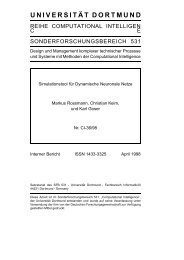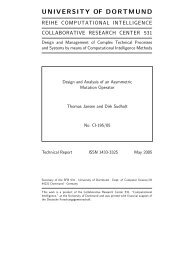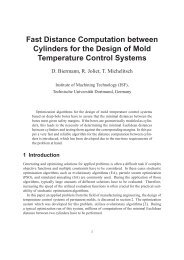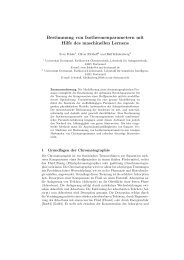Self-Adaptive Genetic Algorithms with Simulated Binary Crossover
Self-Adaptive Genetic Algorithms with Simulated Binary Crossover
Self-Adaptive Genetic Algorithms with Simulated Binary Crossover
You also want an ePaper? Increase the reach of your titles
YUMPU automatically turns print PDFs into web optimized ePapers that Google loves.
tical~vis used for all algorithms. Figure 20 shows the progress towards the ridge axis <strong>with</strong> real-parameter<br />
GAs, <strong>with</strong> non-isotropic self-adaptive ESs, and <strong>with</strong> ES-SBX algorithm. The self-adaptive ES has a faster<br />
progress rate. However, it is worth mentioning that a non-recombinative self-adaptive (10,100)-ES performs<br />
poorly in this function. However, notice that due to the parameter interactions, the progress along the<br />
Distance along ridge axis<br />
200<br />
180<br />
160<br />
140<br />
120<br />
100<br />
80<br />
60<br />
40<br />
20<br />
0<br />
SBX<br />
-20<br />
0 500 1000<br />
Generation Number<br />
1500 2000<br />
ES<br />
ES-SBX<br />
BLX-0.5<br />
Figure 20: Performance of real-parameter GAs<br />
<strong>with</strong> SBX and BLX-0.5, non-siotropic selfadaptive<br />
(10/10,100)-ESs, and (10,100)-ES-SBX<br />
are shown on the rotated ridge function F4-2.<br />
inx1<br />
100<br />
SBX, std dev in x_1<br />
SBX, std dev in x_2<br />
ES, mut str in x_1<br />
10<br />
ES, mut str in x_2<br />
1<br />
0.1<br />
0.01<br />
0.001<br />
0 500 1000 1500 2000<br />
Population diversity or mutation strength<br />
Figure 21: Population standard deviation<br />
Population diversity or mutation strength<br />
andx2for GAs <strong>with</strong> SBX and population average<br />
mutation strengths inx1andx2are shown for<br />
the rotated ridge function F4-2.<br />
ridge axis is now not exponential to the generation number, rather the progress is linear. Since to improve<br />
along the ridge, allNvariables need to be changed in a particular way, the progress slows down. However,<br />
both algorithms have been able to maintain a steady progress. Real-parameter GAs <strong>with</strong> BLX-0.5 also has<br />
progress towards optimum, but the progress is slow. The (10,100)-ES-SBX algorithm (<strong>with</strong>=1) is able<br />
to find better performance than GAs <strong>with</strong> the SBX operator.<br />
Figure 21 shows the population average standard deviation inx1andx2for real-parameter GAs <strong>with</strong><br />
SBX operator and the population average mutation strength inx1andx2. In contrary to their evolution<br />
in the parabolic ridge F4-1 (Figure 19), here, these quantities in both algorithms reduce and fluctuate in<br />
a certain range. More importantly, these quantities for variablesx0andx1now varies in the same range.<br />
This can also be explained as follows. In the rotated ridge function, the ridge axis~vis a random direction,<br />
other than any coordinate direction. For the same reason, any orthogonal direction to the ridge axis is<br />
also a non-coordinate direction. In order to simultaneously satisfy both subgoals of maximizing progress<br />
towards the ridge axis and minimizing the distance to the ridge axis, the best an algorithm can do is to<br />
have a compromise in the rate of growth in each variable direction. In this case, both algorithms make<br />
careful changes to variables by keeping the population diversity or the mutation strength small so that a<br />
compromise in both subgoals is achieved. Naturally, this reduces the overall progress rate along the ridge<br />
axis. However, it may be mentioned here that such a linear behavior of rotated ridge functions is inevitable<br />
for any self-adaptive strategies which work <strong>with</strong> adaptations in variable directions independently. For a<br />
strategy which has the capability to independently adapt variations in arbitrary directions (not necessarily<br />
the coordinate directions), an exponential progress towards optimum <strong>with</strong> generation number may be<br />
possible (Hansen and Ostermeier, 1998).<br />
6 Future Studies<br />
This study suggests a number of extensions, which are outlined in the following:<br />
1. Real-parameter GAs <strong>with</strong> SBX operator can be compared <strong>with</strong> other self-adaptive ES implementations.<br />
19








